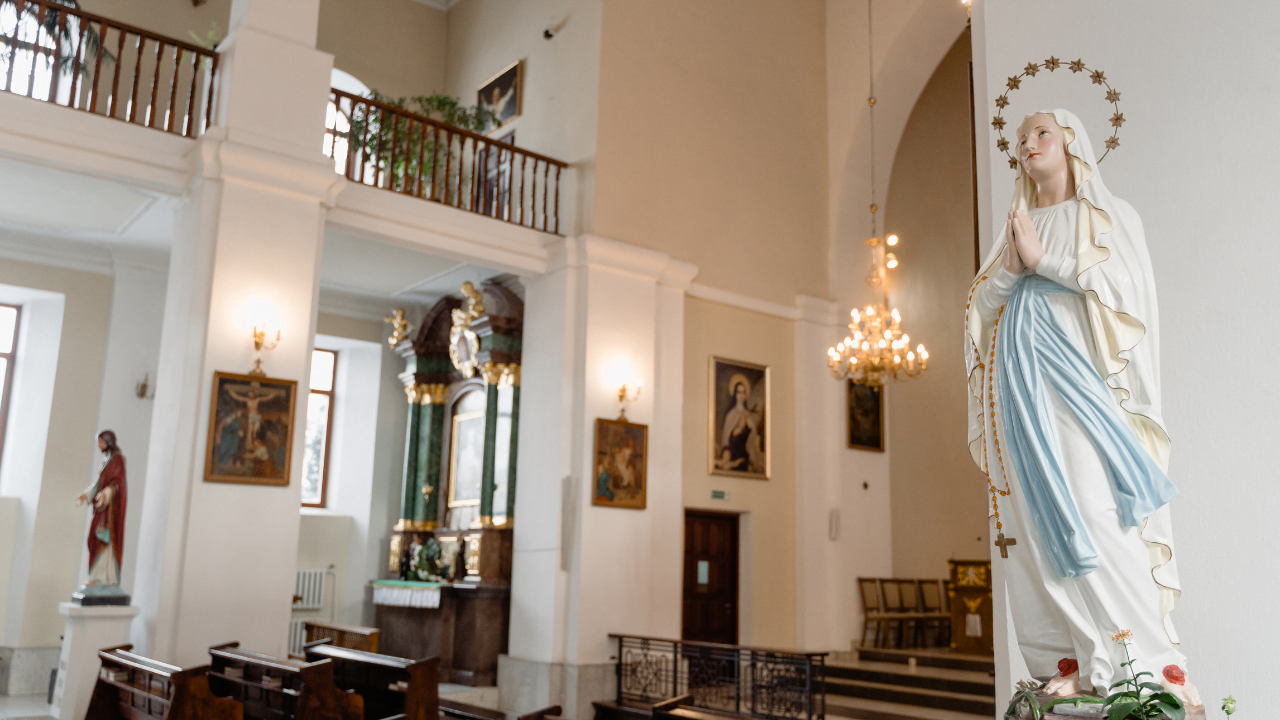No products in the cart.
How do Christians view the concept of sacred space in church architecture?
This post contains paid and/or affiliate links. I make a small commission at no extra cost to you. Please see our Privacy Policy.
Historically, Christians have been revered for the spaces where they gather to worship and commune with God. These sacred spaces, often in the form of churches, reflect the Christian community’s beliefs, traditions, and spiritual experiences. In this article, we will delve into the evolution of church architecture and explore the symbolism and significance behind different architectural styles.
From the earliest days of Christianity, believers gathered in private homes or synagogues to worship. However, as the faith grew, Christians began to embrace specific architectural styles to create sacred spaces that enhanced their connection with the divine. Roman building styles, such as the basilica, were adopted by Christians, signaling a shift towards grandeur and reverence in their worship spaces.
Over time, different architectural styles emerged, each with its unique symbolism and purpose. The Romanesque period, prevalent until the 12th century, featured a rectangular shape with an apse at one end, creating a solemn and enduring atmosphere. The Gothic style, which followed, introduced soaring towers, flying buttresses, and intricate stained glass windows, aiming to create an awe-inspiring and illuminated space that pointed to the glory of God.
The Eastern Orthodox Church developed a distinct architectural style characterized by square-shaped churches covered by domes. This style embodies an air of mysticism and draws on Byzantine traditions. Iconography, statues, and stained glass were widely incorporated in churches across different architectural styles, serving as visual representations of the Scriptures and evoking a sense of the sacred.
With the advent of the Protestant Reformation, a new approach to church architecture emerged. Reformers sought to create a more straightforward, more focused space, emphasizing the preaching of the word of God. Elaborate decorations, statues, and artwork were often removed, making way for plain walls and glass windows that allowed the light of God’s word to shine. This emphasis on simplicity and the importance of the Scriptures forged a direct and personal connection with God during worship.
Today, the concept of sacred space in church architecture continues to evolve. Modern Christians have various architectural styles and designs for their congregations. Innovative materials and structures allow for experimentation, while some groups gather in non-traditional locations, like office buildings or storefronts, maintaining the sense of worship found in the early church gatherings in homes. Pursuing meaningful worship experiences that honor God and promote a sense of divine presence remains at the forefront of Christian communities’ considerations when designing their sacred spaces.
Join us as we explore the rich tapestry of sacred space in church architecture, uncovering the meanings and significance of these hallowed places.
The Evolution of Early Christian Churches
Early Christian churches underwent a significant evolution in their architectural form and function. These churches went through various stages of development, starting with small gatherings in private homes, known as house churches. These intimate settings provided a safe space for worship and fellowship, particularly during persecution.
Beyond the confines of private homes, catacombs served as important sacred spaces for early Christians. These underground burial sites also became places of worship and remembrance, where Christians would gather for ceremonies and services.
With the Edict of Toleration in 313, Christians gained the freedom to worship openly, leading to the construction of stone churches. These early churches were built in a Roman basilica or town hall-style, with the altar becoming the focal point of the sacred space. The architecture reflected the growing prominence of Christianity and its desire for a visible presence in society.
In summary, the evolution of early Christian churches saw a transition from gathering in private homes and catacombs to building stone churches in Roman architectural styles. This evolution reflected the changing social and religious climate and the growing significance of Christianity in the ancient world.
Different Architectural Styles and Symbolism
Church architecture has seen the emergence of various styles throughout history, each with its unique characteristics and symbolism. Let’s explore three prominent architectural styles: Romanesque, Gothic, and Eastern Orthodox.
Romanesque
The Romanesque style was prevalent in Europe until the 12th century. It featured a rectangular shape with a prominent apse at one end, symbolizing the heavenly presence. Thick walls and rounded arches were characteristic of this style, reflecting strength and stability. Romanesque churches often had small windows and dim lighting, creating a mysterious and contemplative atmosphere.
Gothic
In the 12th century, the Gothic architectural style emerged as a departure from Romanesque. Gothic churches were designed to be taller and more majestic, inspiring awe and drawing attention to the heavens. Notable elements included flying buttresses, which provided structural support, and large stained glass windows that flooded the interior with divine light. The verticality of Gothic architecture symbolized the union of earth and heaven, while the intricate details and ornamentation showcased the beauty and splendor of God’s creation.
Eastern Orthodox
The Eastern Orthodox Church developed its unique architectural style, often Byzantine, that differed significantly from Romanesque and Gothic. Eastern Orthodox churches were characterized by a square layout covered by a large dome, representing the celestial realm and the presence of God. Elaborate frescoes and mosaics on the interior walls depicting scenes from the scriptures and the lives of saints, conveying the Orthodox belief in the divine presence permeating every aspect of worship.
The use of iconography, statues, and stained glass played a crucial role in enhancing the sacred ambiance of churches across these architectural styles. These visuals served to educate the illiterate, inspire devotion, and depict the stories of faith and salvation.
| Architectural Style | Main Features | Symbolism |
|---|---|---|
| Romanesque | Rectangular shape with an apse | Strength, stability, and the divine presence |
| Gothic | Flying buttresses and stained glass windows | Inspiration, connection between earth and heaven, beauty of creation |
| Eastern Orthodox | Square shape covered by a dome, frescoes, and mosaics | The celestial realm, divine presence, depiction of scripture and saints |
These architectural styles and the rich symbolism embedded within them continue to shape the sacred spaces in Christian churches, inviting worshippers to engage with the divine and experience the divine presence in their midst.
Protestant Reformation and Simplicity
During the Protestant Reformation in the 16th century, a significant shift occurred in how Christians approached church architecture. Influenced by the teachings of reformers like Martin Luther and John Calvin, new ideas emerged that challenged the traditional ornate decorations found in Catholic churches at the time.
These reformers believed that worship should focus on the Word of God rather than elaborate decorations. They sought to create a space that was simple and conducive to the preaching of Scripture.
As a result, many churches underwent a process of decoration removal, with statues, artwork, and elaborate adornments being stripped away. Plain walls, plain glass windows, and minimal furnishings became the norm. The pulpit, altar, and baptismal font were rearranged to emphasize the proclamation of the Word.
“We must strip away the distractions of worldly splendor and turn our hearts and minds to the true source of our faith – the Word of God.”
This focus on simplicity and the importance of the Word of God became a defining characteristic of Protestant church architecture. By removing distractions and adopting a more austere aesthetic, these reformers aimed to create an environment that encouraged deep contemplation and engagement with the teachings of Scripture.
This shift in architectural style and design highlighted the fundamental theological beliefs of the Protestant Reformation, emphasizing the role of Scripture as the ultimate authority in the believer’s life.
Conclusion
As Christians in the modern era, we can choose from a wide array of architectural styles when constructing our sacred spaces. Whether it’s a traditional church building, a repurposed office, or a storefront, the options are endless. With advancements in architectural materials and innovative designs, we can experiment and create worship spaces that reflect our beliefs and values.
While some congregations embrace the traditional aesthetic of grand cathedrals or intimate chapels, others find meaning in meeting within the familiar walls of their homes, reminiscent of the early days of Christianity. This echoes the core essence of faith that transcends physical structures and emphasizes the importance of community and connection.
Today, the concept of sacred space continues to evolve as we seek worship experiences that deeply honor God and foster a sense of the divine presence. Our architectural choices play a significant role in shaping the atmosphere and facilitating meaningful encounters with the Divine. Whether through intricate stained glass windows, symbolic artwork, or minimalist designs that focus solely on the Word of God, the intention remains to create a space where we can encounter and worship the divine in a way that resonates with our hearts.
FAQ
How did the concept of sacred space evolve in church architecture?
The concept of sacred space in church architecture has evolved. In the early days of Christianity, worship took place in private homes or synagogues. Christians’ adoption of Roman building styles, such as the basilica, signaled a shift towards creating sacred spaces that reflected reverence and divine presence. Different architectural styles, like Romanesque and Gothic, were prevalent during different periods, and various Christian traditions have distinct architectural styles.
What were the early Christian churches like?
The first churches were often converted from large rooms in private homes, known as “house churches.” These early gatherings were sometimes kept secret to avoid persecution. Outside of Rome, Christians also used catacombs for burial and remembrance ceremonies, which served as sacred spaces. With the Edict of Toleration in 313, Christians began building stone churches in the Roman basilica or town hall style, with the altar becoming the focal point of the sacred space.
What are some different architectural styles used in Christian churches?
Romanesque architecture, prevalent until the 12th century, featured a rectangular shape with an apse at one end. Gothic architecture, which emerged in the 12th century, incorporated flying buttresses and large stained glass windows to create a more illuminated and grand space. The Eastern Orthodox Church developed a square-shaped church covered by a dome. Iconography, statues, and stained glass were often used in churches to depict scenes from the scriptures and enhance the sacred ambiance.
How did the Protestant Reformation impact church architecture?
Some reformers advocated stripping church interiors of elaborate decorations, statues, and artwork during the Protestant Reformation. They sought to create a simple and focused space where preaching the word of God could take center stage. Plain walls, plain glass windows, and rearranging the pulpit, altar, and baptismal font were standard practices during this period.
What does the sacred architecture look like today?
Today, modern Christians in the West have a wide range of architectural styles for their churches. Architectural materials and innovative designs allow for experimentation. Some congregations meet in non-traditional locations, like office buildings or storefronts, while many still gather in homes, echoing the early days of Christianity. The concept of sacred space continues to evolve as Christians seek meaningful worship experiences that honor God and foster a sense of the divine presence.











